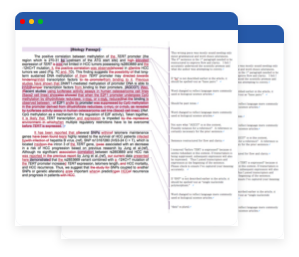Parentheses and Brackets ( ) [ ]
Parentheses are a pair of rounded brackets ( ) used to enclose numbers, words, phrases, or sentences considered to be additional information. In academic writing, equations, acronyms, and in-text citations usually go inside the parentheses.
Depending on the style formatting, square brackets [ ] are used to enclose numbers, words, phrases, or sentences that modify direct quotations and provide appropriate context. This modification is made by the author applying the bracket, not by the original writer of the text that is put in the bracket.
Parentheses and brackets are both used to give readers extra information, but how to use parentheses and brackets may be confusing. Read through this guide to learn the differences between these two punctuation marks and how to use them appropriately.
What is the Difference Between Parentheses and Brackets?
The greatest difference between parentheses and brackets is that parentheses are used to provide the reader with additional information, and brackets are used to provide clarification.
For example, parentheses are used inside sentences or text to add further explanation, acronyms, or any other supportive information the writer wants to add. Therefore, the meaning of a sentence containing parentheses would not be altered if the parentheses were to be removed.
- Example
- The COO position went to Sam Anderson (the son of the current CEO).
- Example
- He received a generous bonus ($5,000) from work.
Brackets are mainly used to add words or phrases added by someone else other than the original writer or speaker in order to clarify the situation or add additional information. Adding brackets clarifies the meaning of the text for readers.
- Example
- He drove 130 [kilometers per hour] on the highway.
- Example
- It was hard for her to finish it [her writing assignment].
Side-by-Side Parentheses
Side-by-side parentheses are used when two or more parenthetical elements need to be placed together inside a single phrase or sentence. Usage rules for side-by-side parentheses differ by academic style guide.
APA style recommends using only one parenthesis and separating the parenthetical elements with a colon.
- Example
- The results of the study were submitted by the Centers for Disease Control and Prevention (CDC; Odin, 2018).
Chicago style also recommends using only one parenthesis but allows using side-by-side parenthesis if the parenthetical elements are unrelated. When using two sets of parentheses, there must be a space between them.
- Example
- The results of the study were submitted by the Centers for Disease Control and Prevention (CDC), (Odin, 2018).
Nested Parentheses
Nested parentheses are parentheses enclosed inside another set of parentheses. Nested parentheses look like this: (parenthetical text (nested text ) parenthetical text)
Nested parentheses are frequently allowed in academic texts written in British English. However, when possible, it is better to avoid using nested parentheses and rephrasing the sentence to use only one parenthesis and/or an em dash.
Nested parentheses are also often allowed in American English academic texts. But as with British English, it is recommended to rephrase the sentence to include only one parenthesis. If using nesting parentheses is too difficult to avoid, using the square brackets instead for the inner elements is recommended.
- Incorrect
- (Additional information is available on the website (website link) of the journal.)
- Correct
- (Additional information is available on the website [website link] of the journal.)
Parentheses or Brackets with Surrounding Punctuation
Content within the parentheses should be treated as an independent element in a sentence.
Punctuation marks such as periods, question marks, and exclamation points can be placed both inside and outside the parentheses or brackets, depending on the situation.
-
If the phrase that goes inside the parentheses or brackets is a full sentence, periods go inside the parentheses or brackets.
- Incorrect
- I want to go home. (I'm so tired).
- Correct
- I want to go home. (I'm so tired.)
-
If the phrase that goes inside the parentheses or brackets is not a full sentence, the period goes outside the parentheses or brackets.
- Incorrect
- The study will continue into the future (until May 2021.)
- Correct
- The study will continue into the future (until May 2021).
-
Commas are placed outside the parentheses or brackets when the parentheses or brackets appear at the end of a clause within the sentence.
- Incorrect
- The chart for this data (number of women in the workplace,) is incorrect and the argument should be revised.
- Correct
- The chart for this data (number of women in the workplace) is incorrect and the argument should be revised.
-
If the phrase that goes inside the parentheses or brackets requires a question mark or an exclamation point, the question mark or exclamation point is placed inside the parentheses or bracket.
- Incorrect
- The woman (the one with a blue dress)! visited me.
- Correct
- The woman (the one with a blue dress!) visited me.
-
If the bracketed phrase includes a question mark or an exclamation point, it requires a period after the parentheses or bracket when placed at the end of the sentence.
- Incorrect
- I can't believe he didn't invite me (after all I did for him!)
- Correct
- I can't believe he didn't invite me (after all I did for him!).










